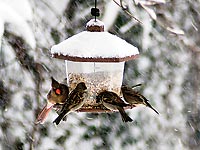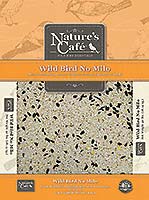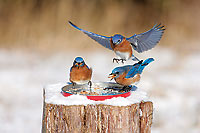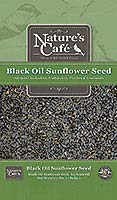 When we moved in to our current home in Moab, I was struck by the number of wild birds that had taken up permanent residence in two very large juniper trees in the front yard and immediately set up several bird feeders around the yard. Many years later, the number of feeders has multiplied; the diversity of birds that visit and take up residence in the yard has changed drastically. When we moved in to our current home in Moab, I was struck by the number of wild birds that had taken up permanent residence in two very large juniper trees in the front yard and immediately set up several bird feeders around the yard. Many years later, the number of feeders has multiplied; the diversity of birds that visit and take up residence in the yard has changed drastically.
This year I have Scrub Jays, Stellar Jays, Chickadees and Robins moving in permanently in addition to the countless number of finches, sparrows and other small wild birds that call our yard home. We have also been visited by a Sharp Shin Hawk frequently since the spring. I choose to feed the wild birds in my yard because I enjoy their songs, they entertain my cats through the windows and are always happy to remove pests from my gardens in exchange for a steady flow of food and shelter. I feed these birds year-round; the quantity fluctuates throughout the year but I find it is most important to feed them through the cold months.
Feeding birds in winter can be rewarding and enjoyable in the midst of chilly weather and lifesaving for the birds that frequent your feeders. By understanding which birds are around in winter and what they need to eat, both novice and experienced backyard birders make the most of their feeders during the coldest months of the year. Most birds develop feeding patterns, moving from food source to food source along a regular daily route. The birds visiting your yard will start to rely on your feeding stations, especially during winter storms, cold snaps and other critical times.
If you don’t feed the birds, the birds may not have time to find other sources to last them through the emergency. If you start feeding birds, it’s very important that you feed them every day through the winter and well into the spring. Their survival could depend on your feeding station.
Feeding stations can be simple or complex. Simply scattering food on the ground or hanging a bird feeder in a tree are examples of simple stations. Providing multiple feeders with different seeds, types of perches, multiple sized openings and varying how high you place each feeder, is an example of a complex feeding station.
Different types of food attract different types of birds, so setting up a complex feeding station should increase the variety of birds you see. Wild birds have the easiest time finding food when the food is placed in an area where the birds would naturally look for it. Four basic feeding locations will accommodate most of the seed eating birds: ground, table top, hanging and tree trunk.
As you set up your feeding station, keep two things in mind variety and safety. Providing a variety of foods and feeders, placed at different heights, will attract a greater selection of birds.
Spread your feeders out to avoid concentrating a large number of birds in one area. And find or create areas where it’s easy to clean up spilled seeds and other messes. This will help control the spread of disease and food poisoning from mouldy or spoiled seeds.
In addition to a constant, reliable source of food, the birds you attract need safe, protected places to eat and rest. Natural settings birds normally use are great places to put a feeder. Birds select these areas because they not only block the wind and the weather, they also offer escape cover from housecats and other predators. A protected yard is also a good place to put a feeder. Locate the feeder in the open, away from any cover that cats might use to sneak up on feeding birds.
Also, remember to place your feeders where you can easily see them. A good place is near a window, a balcony or another place where you can see the birds without disturbing them. Placing a feeder close to a window will actually cut down on birds flying into the window because, after leaving the feeder, the birds won’t have time to build up much speed.
Most birds that visit backyards in cold weather thrive on seeds, since insects and fruit are harder to find naturally during the winter. The best foods to offer wild birds in cold weather have a high fat or oil content that will provide abundant energy for winter survival. Nutritious cold weather seeds for wild birds include black oil sunflower seeds, grey striped sunflower seeds, white and red millet, thistle or Niger seeds. Nature’s Café for Wild Birds offers all of these items in sizes of 5# to 40#, available exclusively at the Moab Barkery.
Suet and fruit will also attract birds. Suet, which is another name for fat, is a rich source of energy for some birds. Simply stuffing the suet into cracks in the bark can turn a tree trunk into a good suet feeder. Fortunately, birds are more interested in the food than the cost of your feeder or how the feeder looks. Feeders made at home or bought in a store can both work equally well. Just make sure your feeder keeps the seeds in it dry and has enough openings so the birds can reach the food.
Stored properly, seed can easily last for months, particularly seed mixes and sunflower seeds. To properly store seed, it should be kept in a cool, dry place that is protected from bugs and rodents; a Vittle Vault is great for this and can hold up to 40# of seeds. Have a scoop on hand to easily refill feeders, and you’ll use more seed than you think and you will to satisfy the wild bird’s winter appetite.
To make the most of feeding wild birds in the winter clean off feeders, platforms and perches often so the seed is easily accessible. Add a heated bird bath to your yard or provide a daily water source to provide birds with water that is not frozen. Stamp or shovel snow around feeders to provide easier access to spilled seed for ground feeding birds. Leave nesting boxes and bird house up all year round to provide winter roosting sites.
With care and consideration feeding wild birds over the cold months can be entertainment for you and a lifeline to survival for wild birds, with birdsong and backyard visits to brighten the coldest, darkest days of the season.
|